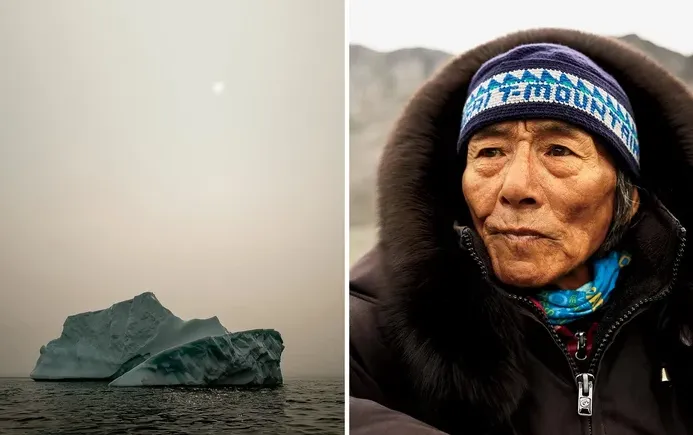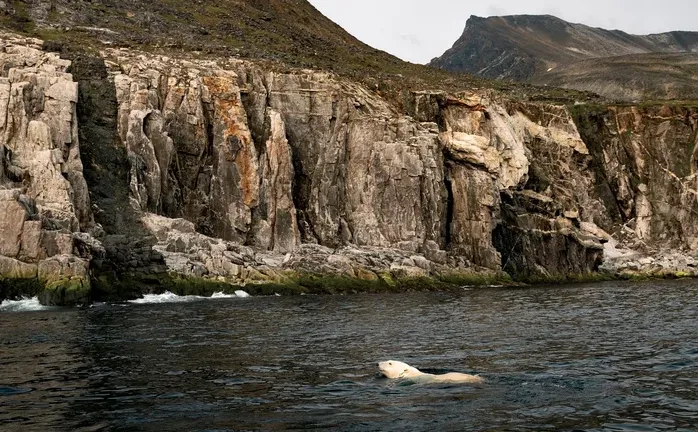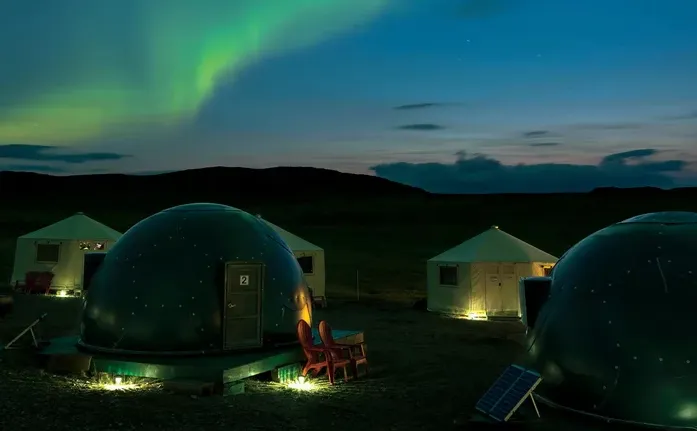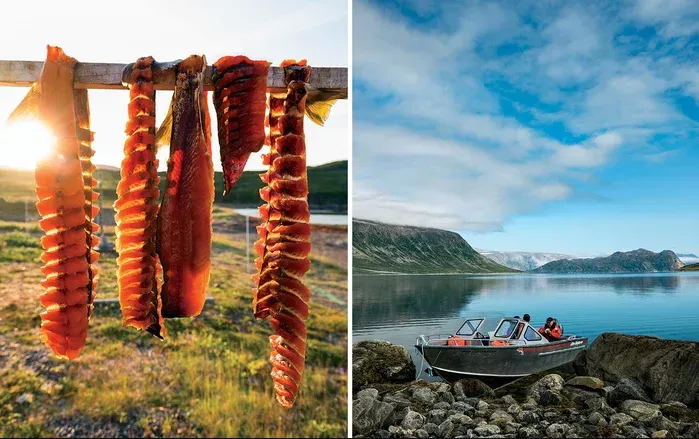This Spectacular Canadian Wildlife Reserve Is So Remote, You Can Only Get There Five Weeks a Year
Among serious adventure seekers, word is spreading about Torngat Mountains National Park—an Inuit-run reserve in Labrador, Northeastern Canada
/https://tf-cmsv2-smithsonianmag-media.s3.amazonaws.com/filer/b9/ae/b9aedd67-2283-418a-a055-272df8e26cc2/screen_shot_2018-07-16_at_30352_pm.png)
Canada’s Inuit people call the polar bear nanuk. In Torngat Mountains National Park, an Inuit-run nature reserve in the northernmost part of Labrador, I lost count of how many nanuks I saw, often just yards away, in the space of four days. As I skimmed the bottle-green depths of the park’s spectacular fjords in a Zodiac, they appeared everywhere: prowling the coastline, paddling through the shallows, surveying their dominion from the barren mountainsides.
My guides were three senior members of the Inuit community: Jacko Merkuratsuk and cousins John and Paul Jararuse. They explained that polar-bear populations in northeastern Canada are not just healthy but may actually be on the rise, thanks to regional conservation programs. They pointed out a mother and her two cubs swimming across a bay, their snouts and little round ears poking out of the frigid waves. We were able to get so close we could hear them hissing, a warning sound not unlike steam escaping from an engine. After peering at us and huffing a few times, the creatures chugged toward land, leaped onto shore, and began lumbering away over the boulders at remarkable speed. I stared after them in astonishment: I had never seen wildlife of such grandeur before.
The nanuk commands serious respect among Inuit people, and with good reason. On arriving at the Torngat Mountains Base Camp, every visitor has to watch a half-hour video about staying alive in polar-bear country. The film makes it clear that the bears are highly intelligent and, as the alpha predator in these parts, not to be underestimated. The recommended response to a surprise face-to-face encounter goes as follows: aim desperate punches at the animal’s nose and, as the narrator shouted into our screen, “FIGHT FOR YOUR LIFE!”
Fortunately, there’s a sizable team of rifle-bearing Inuit guards in the park, and no visitor is allowed to venture beyond the buffer zone surrounding the base camp’s fenced-in, electrified perimeter without being accompanied by at least one of them. Several years ago, I was told, a group of hikers who attempted an overnight trip without notifying the guards were attacked as they slept in their tents, and one was mauled nearly to death. The lesson was clear: in the Torngats, if it’s humans versus the wilderness, the wilderness will win.
Like many Canadians, I’m fascinated by the idea of the far north, and by the possibility of connecting with and learning from the people whose ancestors inhabited this land long before European settlers arrived. Labrador borders my home province of Quebec, yet no Quebecker I know has ever been to the region. That’s partly because it’s complicated and expensive to get there, but also because, until the Torngat Mountains National Park’s visitor-friendly base camp was upgraded in 2010, there weren’t many places to stay. The camp, which doubles as a research facility, is open for just four or five weeks of the year, from late July to late August — the only time it’s warm enough to visit. Guests spend their days taking guided expeditions into the wilderness: hiking is the way to explore by land, helicopter by air, and Zodiac by sea.
The name Torngat means Place of Spirits in Inuktitut, the Inuit language. In the past, Inuit shamans would venture into this mountainous, 3,745-square-mile wilderness to communicate with the spirit realm. The park is located in the far northern tip of the remote, rugged province of Newfoundland and Labrador, within the autonomous Inuit region of Nunatsiavut. Inuit lived there year-round until the completion of a government-led relocation effort in 1959. One of the Inuit community’s guiding principles is defined by the phrase, “You find what you seek.” Should you be the kind of traveler who seeks a profound sense of our planet’s majesty, you will find it there.

Some rocks in the Torngats are almost 4 billion years old, making them among the oldest on earth. Simply being on my feet felt like straddling history — I could sense a kind of primeval energy billowing up from the ground. The mountains are geological mille-feuilles striated with ancient minerals in layers of ocher, copper, and taupe. In the park cafeteria one morning, I met a geologist who told me about the origins of this extraordinary topography, explaining that, many millennia ago, continental rifts caused the earth’s mantle to burst through its surface. In a way, he said, this is what the planet would look like turned inside out.
The park isn’t simply one of Canada’s most striking corners; it also embodies the nation’s efforts at reconciliation with its aboriginal peoples. The Inuit and their predecessors have inhabited Arctic Labrador for millennia, but during the 1950s, the government forced those communities to relocate southward, mainly to the towns of Nain, Hopedale, and Makkovik, where they were cut off from their way of life and underwent the notorious traumas of Canada’s residential school system. As part of land-claim settlements signed in 2005, the federal government agreed to hand control of this territory back to the Labrador Inuit and, in 2008, delivered on its promise to protect the Torngat region by granting it full national park status.
Flying there takes anywhere from a day or two up to a week, depending on the weather. This is the Arctic: scheduling extra days for contingencies is recommended. A fisheries researcher I met on the trip told me he recently sat through 10 days of storms waiting for flights to resume. “A week and a half late! The wife back home was pretty furious, eh?”
I was luckier. Arriving at Labrador’s Goose Bay airport with my friend John Cullen, who took the photographs for this story, I found our flight was due to take off within a few hours of its scheduled departure time. Once the conditions were right, a Twin Otter took us to Nain, the province’s northernmost town, and then an hour or so north to Saglek Bay, just outside the park. The plane, though cold and cramped, delivered a series of mind-blowing glimpses of the landscape below. I watched a pod of porpoises skim through the turquoise surface of the Labrador Sea and moose roam through the swaths of coniferous woodland covering the rocky Canadian Shield. The terrain was broken up by mirror-gray lakes, violet waterways, and forest-green bays. Then the spruce trees began to get smaller and sparser, until there were no trees anymore. We were now above the tree line, in the Arctic tundra.
Soon, we were out over the ocean, a wrinkled cerulean tapestry broken, here and there, by icebergs. Then we entered a patch of cloud. The air in the plane grew colder. When the mist began to part, huge shapes appeared in the distance, indistinct at first. I couldn’t tell if they were mountains or some kind of low-air-pressure-induced hallucination. These were the Torngats, their glacier-capped peaks protruding above the clouds.
“What an incredible flight!” I exclaimed to the pilot as we stepped out onto the gravel landing strip at Saglek. “You haven’t even seen the really beautiful stuff yet,” she said. “This is just the beginning.”
Arriving at Torngats base camp must feel a little like arriving on the moon. Part of the reason for that is the accommodation: a series of extraterrestrial-looking green geodesic domes, each of which comes equipped with propane heaters — crucial for getting through the chilly Arctic nights. The outer-space effect is compounded by the fact that the archaeologists, naturalists, and other scientists who use the camp as a research station, as well as many of the Inuit staff, often walk around in full-body mosquito suits, moon boots, and snow pants to protect themselves against the elements and the bugs. You’re also cut off from the rest of the world. There is a satellite phone for emergencies, and a weak Internet signal can sometimes be accessed in the cafeteria, but that’s it. Guests become part of a tiny human enclave set within a vast, permafrost wilderness.
On our first afternoon, we set off to explore the coastline by boat. Within minutes, we came across a massive iceberg drifting gently through the doldrums of the Labrador Sea like a blazing white palace. Everyone knows that the majority of any iceberg is actually submerged, but there’s something transformative about seeing the mansion-size tip with your own eyes, and contemplating what lies beneath. We could hear what’s known as the “bergy seltzer” — a popping soda-like sound caused by thousand-year-old air escaping from pockets in the ice.

Beyond all the polar bears, I was amazed at how much wildlife we spotted from the water as we toured the park coastline, from caribou on the tundra to bearded seals frolicking off the ice floes. Looking down through gin-clear water to the ocean floor, we could see colonies of sea urchins everywhere — enough uni to last several lifetimes. At one point, we rounded a headland to see a minke whale breaching right in front of our boat, flashing its dorsal fin as if flirting with us.
I asked John Jararuse what went through his mind when taking in such sights. “Home,” was his simple reply. Later that morning, he steered our boat into another fjord to show us a little plateau of greenery just above the shoreline, with nothing but a soaring wall of rocks as shelter. “This is where I was born,” he said. We all bobbed there in silence for a moment, imagining the drama of birth in such an open environment, so far from a hospital or modern comforts of any kind.
Inuit livelihoods have changed radically over the past half-century. Hunting and fishing are still a way of life, but these days, Merkuratsuk and the Jararuses live in Nain year-round, traveling to the Torngats for seasonal work. John Jararuse spoke to us of the painful realities he had experienced during the resettlements, being separated from his home and loved ones. But all the Inuit I met on this trip shared a sense of optimism and relief that this place has been returned to its rightful custodians. “Now that this is a national park, it will be safe for other generations,” Paul Jararuse said.
As we navigated the coastline, our guides talked about the old ways, how their families had thrived on this land, of their own happy childhoods here. They’d lived in the Torngats year-round, spending winter in igloos and sod houses at first and, later on, in homes they’d built in a now-abandoned community named Hebron. To survive in such an extreme climate (it’s so cold that, in places, the ground stays frozen all year) they relied on skills developed by their ancestors centuries earlier. These included being able to identify the medicinal properties of an array of fantastical-sounding indigenous plants. Their pharmacopoeia included a medicinal cottony grass called suputaujak, whose fluffy white seeds can be inserted into ear canals to help with earaches or used to staunch a newborn’s bleeding navel. They’d chew a tundra flower called the river beauty to prevent nosebleeds and mix black crowberries with fish roe and seal blubber to make suvalik, a kind of Inuit ice cream. As kids, they’d rub the leaves of northern bunchberry plants on their faces and giggle at the tickling sensations they caused.
As we bounced around through the waves, every new vista brought a fresh astonishment, from the shock of sudden color on a mossy hillside to the tranquility of mist curling through the opalescent bays. The mountains seemed as imposing and impressive as cathedrals of stone. In places, erosion had caused some of them to shatter apart into piles of scree deposits, which in turn had gradually formed rivulets of what look like crushed Oreo cookies. We saw Mount Razorback, ridged with jagged points, and Blow Me Down Mountain. “The name describes it, I’d say,” Merkuratsuk offered. “It’s windy up there. People have gotten blown off mountaintops here and died.”
On our last night, two Inuit throat singers joined us around the campfire, chanting in transcendental tones. In the past, missionaries forbade these songs, branding them demonic. Fortunately, the tradition survived, and anyone hearing the singers today can’t help being transfixed by the way they emulate the sound of wind coursing past rocks or water rushing along a riverbed.

As they sang, the northern lights appeared overhead, bright green vectors arcing through the firmament like gigantic flashlights. As we stood there next to the bonfire, our heads craned upward, it felt like something, or someone, was shining immense tunnels of light through the sky in order to survey its territory.
“How can you not believe in spirits in a place like this?” asked Evie Mark, a throat singer and cultural liaison for the park. “I sing to them all the time — to the spirit of the elements, of the mountains, of the rivers.”
These elements are perhaps at their most breathtaking in the corridor of cliffs rising above Tallek Arm, off Nachvak fjord. We were lucky enough to take a helicopter ride to that part of the park and, from above, got a sense of how the minerals leaching out of the mountains affect the surrounding waters. Some rivers were deep black, while other bodies of water shimmered with iridescent tones ranging from magenta to jade. Near Little Ramah Bay, we spotted a lake the pale blue of milky sapphires.

On my final afternoon, I joined a group of the staff on a fishing excursion. After casting for a while, I sat down on the shore next to Andrew Andersen, the park’s half-Inuit, half-Australian visitor-experience coordinator. “Guests want to hike and see polar bears and icebergs — all that’s super, but we also like it when visitors want to engage with us Inuit,” he told me. “A lot of people come here without knowing that this culture — our culture — is here. Many of them say that coming here changed their life, that it made them think in different ways.”
Andersen’s father, William Andersen III, was the president of the Labrador Inuit Association during the nineties and early aughts, and he played a key role in the talks that led to the national park status for Torngats. Andersen told me how his father spoke of this region as the Inuit gift to the rest of Canada and, by extension, the rest of the world. For travelers lucky enough to come here, that gift brings with it the chance to see this place as the Inuit do: as a land alive with elemental forces.
When I mentioned this to Andersen, he said that the relationship goes both ways. “Seeing this place the way you see it — the way newcomers react to things we’re familiar with — is also a gift for us, because it constantly allows us to see our homeland through fresh eyes and to be reminded of how special this place is,” he said. “Like all true gifts, it benefits the giver as much as the receiver.”
How to Visit Torngat Mountains National Park
Set aside a week for a trip to this icy, rugged wilderness. You’ll need to plan carefully, but the experience will be unforgettable.
Getting There
Air Canada flies to Labrador’s Goose Bay airport from major U.S. hubs. From there, Parks Canada will arrange a puddle-jumper to Nain and, from there, a private charter flight to the Torngat landing strip. Weather delays are common and can last several days, so schedule extra time for contingencies.
Tour Operator
The park is open to visitors for only five weeks a year, so book well in advance. Base camp accommodations—huts and fiberglass domes — can comfortably accommodate up to six people and come with electricity and propane heaters. It is also possible to camp within the fenced-in property, in either your own tent or one provided by the park. In all cases, bathrooms and showers are shared. The four- or seven-night Tuttuk package, available through the park authority’s website, includes lodging, meals, guided excursions, cultural activities, and flights to and from Goose Bay. thetorngats.com; from $4,978 per person. Helicopter tours start at $750.
What to bring
Pack wool socks, hiking boots, long johns, and rainproof gear; a down jacket and pants may also come in handy. Sunscreen and bug spray are essential.
Other articles from Travel + Leisure:
- You Can Swim — and Sing — With Adorable Beluga Whales in Canada
- This Breathtaking Landscape Is Canada's Newest Protected Area
- The Best Places to See Penguins, Polar Bears, Narwhals, and More
Planning Your Next Trip?
Explore great travel deals
Smithsonian magazine participates in affiliate link advertising programs. If you purchase an item through these links, we receive a commission.